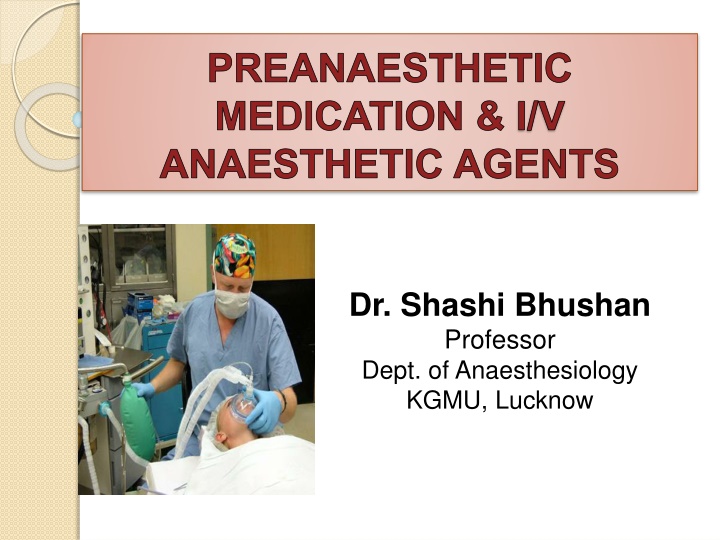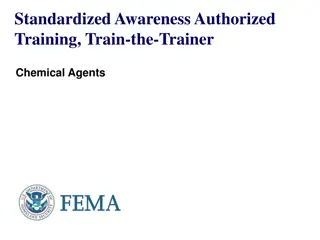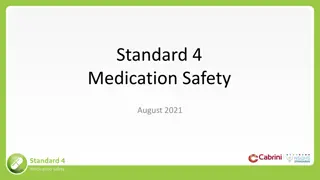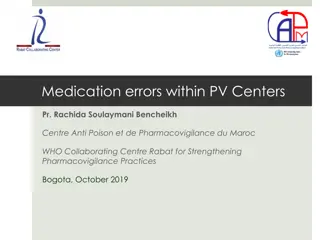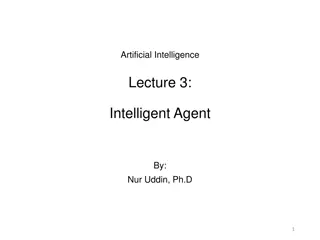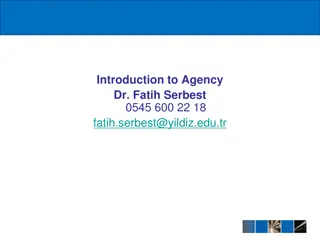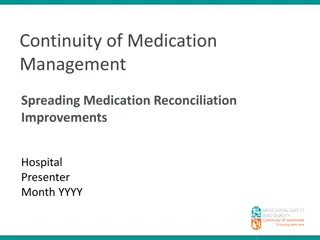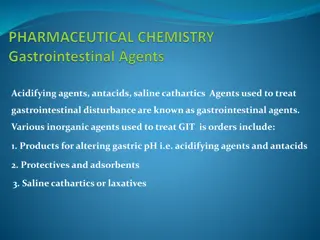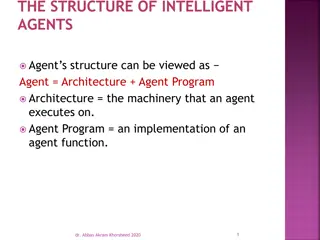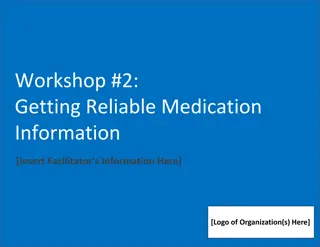Preanaesthetic Medication & I/V Anaesthetic Agents Overview
Preanaesthetic medication aims to provide relief, reduce anxiety, induce amnesia, and enhance the effects of general anaesthetics for a safer and smoother anaesthesia experience. Various drugs such as anti-anxiety medications, sedatives, hypnotics, opioid analgesics, and anticholinergics are used in pre-anaesthetic medication to ensure patient comfort and minimize adverse effects.
Download Presentation

Please find below an Image/Link to download the presentation.
The content on the website is provided AS IS for your information and personal use only. It may not be sold, licensed, or shared on other websites without obtaining consent from the author.If you encounter any issues during the download, it is possible that the publisher has removed the file from their server.
You are allowed to download the files provided on this website for personal or commercial use, subject to the condition that they are used lawfully. All files are the property of their respective owners.
The content on the website is provided AS IS for your information and personal use only. It may not be sold, licensed, or shared on other websites without obtaining consent from the author.
E N D
Presentation Transcript
PREANAESTHETIC MEDICATION & I/V ANAESTHETIC AGENTS Dr. Shashi Bhushan Professor Dept. of Anaesthesiology KGMU, Lucknow
Overview Pre-anaesthetic Medication Drugs used in pre-anaesthetic medication General Anaesthetics History Stages of anaesthesia Pharmacokinetics Mechanism of action Complications of general anaesthesia Summary
Preanaesthetic medication is the term applied drugs to the to It administration general anaesthesia so as to make anaesthesia safer for the patient of prior Ensures comfort to the patient & to minimize adverse anaesthesia effects of
Aims Relief preoperatively & facilitate smooth induction of anxiety & apprehension Amnesia for pre- & post-operative events Potentiate action of anaesthetics, so less dose is needed
Aims(contd.) Antiemetic operative period effect extending to post- Decrease secretions & vagal stimulation caused by anaesthetics Decrease acidity & volume of gastric juice to prevent reflux & aspiration pneumonia
Drugs used for preanesthetic medication Anti-anxiety drugs- - Provide relief from apprehension & anxiety - Post-operative amnesia e.g. Diazepam (5-10mg oral), Lorazepam (2mg i.m.) (avoided co-administration with morphine, pethidine)
Sedatives-hypnotics- e.g. sedative, action Promethazine antiemetic (25mg & i.m.) has anticholinergic Causes negligible respiratory depression & suitable for children
Opioid analgesics Morphine (8-12mg i.m.) or Pethidine (50- 100mg i.m.) used one hour before surgery Provide analgesia, reduction in anaesthetic dose sedation, pre-& post-operative Fentanyl (50-100 g i.m. or i.v.) preferred nowadays (just before anaesthesia) induction of
Anticholinergics- Atropine (0.5mg i.m.) or Hyoscine (0.5mg i.m.) or Glycopyrrolate (0.1-0.3mg i.m.) one hour before surgery(not used nowadays) Reduces salivary & bronchial secretions, vagal bradycardia, hypotension Glycopyrrolate(selective acts rapidly, antisecretory bradycardia effectively peripheral acting, prevents action) potent vagal longer agent,
Antiemetics- Metoclopramide antiemetic & as prokinetic gastric emptying agent prior to emergency surgery (10mg i.m.) used as Domperidone (10mg oral) more preferred (does not produce effects) extrapyramidal side Ondansetron (4-8mg i.v.), a 5HT3receptor antagonist, found effective in preventing post-anaesthetic nausea & vomiting
Drugs reducing acid secretion Ranitidine (150-300mg oral) or Famotidine (20-40mg oral) given night before & in morning along with Metoclopramide reduces risk of gastric regurgitation & aspiration pneumonia Proton (20mg) preferred nowadays pump with inhibitors Domperidone like Omeprazole (10mg) is
GENERAL ANAESTHETICS General Anaesthetics (GA) are drugs which produce reversible loss of all sensation & consciousness Neurophysiologic general anaesthetics characterized by five primary effects: state produced by Unconsciousness Amnesia Analgesia Inhibition of autonomic reflexes Skeletal muscle relaxation .
Ideal anaesthetic- - Rapid induction - Smooth loss of consciousness - Rapidly reversible upon discontinuation - Possess a wide margin of safety The cardinal features of general anaesthesia are: Loss of all sensation, especially pain Sleep (unconsciousness) & amnesia Immobility & muscle relaxation Abolition of somatic & autonomic reflexes
Development of intravenous anaesthetic agents such as Propofol Combined with Midazolam, Dexmedetomidine & Remifentanyl anaesthesia (TIVA) as clinically useful tool in modern anaesthetic practice. Led to the use of total intravenous
Intravenous Anaesthetics a. Fast inducers i.) Thiopental, Methohexital ii.) Propofol, Etomidate b. Slow inducers i.) Benzodiazepines Diazepam, Lorazepam & Midazolam c. Dissociative anaesthesia Ketamine d. Opioid analgesia Fentanyl
Pharmacokinetics Procedure for producing anaesthesia involves smooth & rapid induction Maintenance Prompt recovery after discontinuation
Induction Time administration of anaesthetic drug & development of anaesthesia interval between the stage of surgical Fast & smooth induction desired to avoid dangerous excitatory phase
Thiopental or Propofol often used for rapid induction Unconsciousness results in few minutes after injection Muscle Atracurium) co-administered to facilitate intubation relaxants(Pancuronium or Lipophilicity is key factor governing pharmacokinetics of inducing agents
Maintenance Patient remains in sustained stage of surgical anaesthesia(stage 3 plane 2) Depth of anaesthesia depends on concentration of anaesthetic in CNS Usually maintained by administration of gases or volatile liquid anaesthetics (offer good control over depth of anaesthesia)
Recovery Recovery phase starts as anaesthetic drug is discontinued (reverse of induction) In this phase, nitrous oxide moves out of blood into alveoli at faster rate (causes diffusion hypoxia) Oxygen given in last few minutes of anaesthesia & early post-anaesthetic period More common with gases relatively insoluble in blood
Mechanism of Anaesthesia Non-selective in action At molecular level, anaesthetics interact with hydrophobic regions of neuronal membrane proteins Inhaled Benzodiazepines, Etomidate & propofol facilitate GABA-mediated GABAA receptor sites & increase Cl- flux anaesthetics, Barbiturates, inhibition at Ketamine blocks action of glutamate on NMDA receptor
General anaesthetics disrupt neuronal firing & sensory processing in thalamus, by affecting neuronal membrane proteins Motor activity also reduced GA inhibit neuronal output from internal pyramidal layer of cerebral cortex
Intravenous anaesthetics Thiopentone sodium Ultrashort smooth circulation time Crosses BBB rapidly Diffuses redistributed to body fats, muscles & other tissues Typical induction dose is 3-5mg/kg Metabolised in liver acting induction thiobarbiturate, within one rapidly out of brain,
Cerebral cerebral pressure(suitable for patients with cerebral oedema & brain tumours) vasoconstriction, blood flow reducing intracranial & Laryngospasm on intubation No muscle relaxant action Barbiturates in general may precipitate Acute intermittent porphyria (hepatic ALA synthetase) Reduces respiratory rate & tidal volume
Propofol Available as 1% or 2% emulsion in oil Induction of anaesthesia with 1.5-2.5mg/kg within 30 sec & is smooth & pleasant Low movements incidence of excitatory voluntary Rapid recovery with low incidence of nausea & vomiting(antiemetic action) Non-irritant to respiratory airways No analgesic or muscle relaxant action
Anticonvulsant action Preferred agent for day care surgery Apnoea & pain at site of injection are common after bolus injection Produces marked decrease in systemic blood pressure during induction(decreases peripheral resistance) Bradycardia is frequent
Ketamine Phencyclidine derivative Dissociative anaesthesia: a state characterized by immobility, amnesia and analgesia with light sleep and feeling of dissociation from surroundings Primary site of action cortex and limbic system acts by blocking glutamate at NMDA receptors Highly lipophilic drug Dose: 1-2mg/kg i.v.
Only analgesic properties & produces CNS stimulation i.v. anaesthetic possessing significant Increases heart rate, blood pressure & cardiac output Markedly increases cerebral blood flow & ICP Suitable for patients of hypovolaemic shock Recovery associated with emergencedelirium , more in adults than children Use of diazepam or midazolam i.v. prior to administration of ketamine, minimises this effect
Fentanyl Potent, short acting (30-50min), opioid analgesic Generally given i.v. Reflex effects of painful stimuli are abolished Respiratory depression is marked but predictable
Decrease in heart rate, slight fall in BP Nausea, vomiting & itching often occurs during recovery Also employed as adjunct to spinal & nerve block anaesthesia & to relieve postoperative pain
Complications of Anaesthesia During anaesthesia: After anaesthesia: Respiratory depression Salivation, respiratory secretions Cardiac arrhythmias Fall in BP Aspiration Laryngospasm and asphyxia Awareness Delirium and convulsion Fire and explosion Nausea and vomiting Persisting sedation Pneumonia Organ damage liver, kidney Nerve palsies Emergence delirium Cognitive defects
Balanced anaesthesia General anaesthetics rarely given as sole agents Anaesthetics adjuvants used to augment specific components of surgical anaesthesia, permitting lesser doses of GA General anaesthetic drug regimen for balanced anaesthesia: Thiopental + Opioid analgesic(pethidine or fentanyl/ benzodiazepine) + Skeletal muscle relaxant (pancuronium) & Nitrous oxide along with inhalation anaesthetic(Halothane/other newer agents )
Summary Characteristics Anaesthetics Nitrous oxide Highest MAC, Second gas effect, Diffusion hypoxia Used in bronchial asthma, Malignant Hyperthermia Safest in unskilled hands, highly inflammable Agent of choice for induction in children Neurosurgery Dissociative anaesthesia, used in CHF & shock Epilepsy, thyrotoxicosis Day care anaesthesia, i.v. Anaesthetic of choice in patients with Malignant Hyperthermia Aneurysm surgeries & cardiac diseases Halothane Ether Sevoflurane Isoflurane Ketamine Thiopentone Propofol Etomidate
References Pharmacological Basis of Therapeutics, 12th Edition, Goodman & Gilman's Medical Pharmacology, S.K. Srivastava Principles of Pharmacology, 2nd edition K.K. Sharma Review of Pharmacology, 8th edition Gobind Rai Garg
